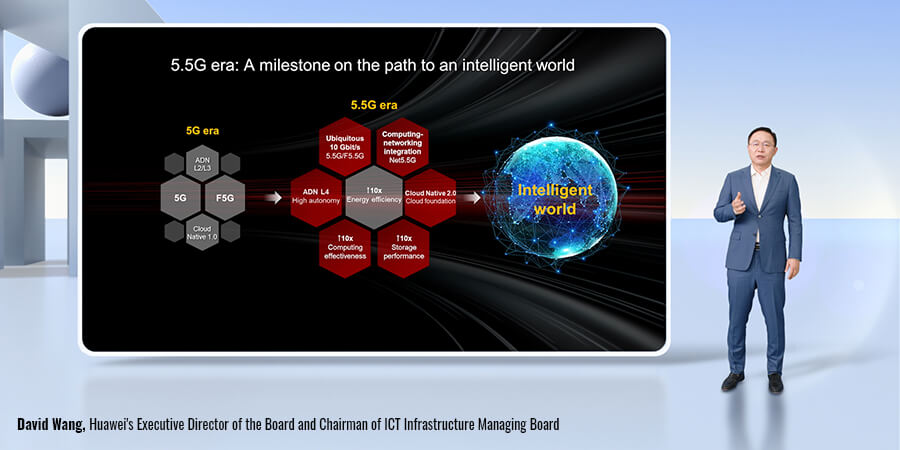At Huawei Connect 2022 today, David Wang, Huawei's executive director of the Board and chairman of ICT Infrastructure Managing Board, delivered a keynote speech entitled Embracing the 5.5G Era: Striding Towards the Intelligent World.
Noting in his speech that 5.5G is a key milestone on our path to an intelligent world, Wang took the opportunity to release Huawei's latest series of white papers on the intelligent world and called upon the ICT industry to coordinate efforts around eight facets of this vision. By working together to further define and refine its vision and standards for the 5.5G era, the industry will move ever faster towards the 5.5G era and the intelligent world.
This will inevitably impact individuals, households and industries as higher requirements are expected for digital infrastructure in a digital era.
For individuals, immersive services like XR and holographic communication are maturing, and the connectivity experience is set to increase from 1 Gbit/s to 10 Gbit/s. Mobile DOU will surge from today's 15 GB to 100 GB in the future. Requirements for latency and ubiquitous connectivity will also increase.
For households, the demands generated by advanced services like 24K 3D VR games and holographic education and meetings are creating a full-fiber, 10 Gbit/s era.
Across industries, digital transformation has now entered the fast lane, and industrial-grade applications such as smart manufacturing and power grid dispatching are raising diversified requirements for connections, quality and sensing while also triggering explosive growth in demand for computing power and storage.
In anticipation of future requirements, Wang stressed, "We must continue to work hard if we hope to reach an intelligent world. The 5.5G era is an important milestone on this path – one we cannot miss. In the 5.5G era, we will need ubiquitous 10 Gbit/s experience; intelligent and high-quality compute scheduling; highly autonomous L4 networks; Cloud Native 2.0 services for enterprises; and a 10-fold increase of computing effectiveness, storage and infrastructure energy efficiency."
To accelerate the advent of the 5.5G era and the intelligent world, Wang shared Huawei's belief in supporting customers, ecosystem partners, industry organizations and academic institutions to continue evolving and reinforcing digital infrastructure.
Industry players will have to come together to achieve the following: promote the allocation of more spectrum to accelerate industry development and continue exploring new 5.5G use cases with greater commercial value; define the technical paths forward and standards for F5.5G; quickly reach a consensus on evolution towards Net5.5G; define a profile for L4/L5 autonomous networks and promote unified standards; build an open and diversified computing industry for shared success and redefine the computing architecture; define a storage architecture that meets diversified data processing requirements; build a cloud foundation for the intelligent world and cultivate a stronger cloud service industry ecosystem; and finally, adopt a unified NCIe system to help industry save energy and reduce emissions with innovative ICT technologies and solutions.
Wang also released Huawei's latest series of white papers, titled “Striding Towards the Intelligent World.” Guided by the next steps relating to the eight facets mentioned above, these white papers explore both the opportunities and challenges that will be presented to major ICT infrastructure domains by emerging business needs and technological developments. The white papers also outline key trends in these domains and specify actions that the company recommends the industry should take before 2025.
Taking to the stage, Dang Wenshuan, Huawei's chief strategy architect, discussed the contents of the white papers and delved into two concepts the company would like to promote.
The first is "ICT for Intelligence," which focuses on constant innovation and evolution in different ICT domains to improve key capabilities. The second concept is "Intelligence for ICT," which focuses on the intelligent and architectural innovation within the ICT industry itself that will be needed to address challenges like increasingly complex O&M, ensuring user experience in diversified service scenarios and green development.
Dang concluded that addressing these challenges will help us make the most of existing and coming core ICT capabilities and lead us to an intelligent world faster.





